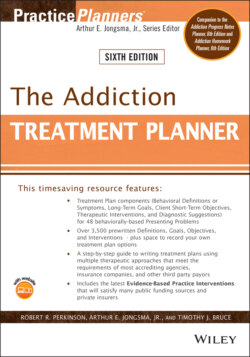Читать книгу The Addiction Treatment Planner - Группа авторов - Страница 13
HOW TO USE THIS TREATMENT PLANNER
ОглавлениеUse this Treatment Planner to write treatment plans according to the following progression of six steps:
1 Problem Selection. Although the client may discuss a variety of issues during the assessment, the clinician must determine the most significant problems on which to focus the treatment process. Usually a primary problem will surface, and secondary problems may also be evident. Some other problems may have to be set aside as not urgent enough to require treatment at this time. An effective treatment plan can only deal with a few selected problems or treatment will lose its direction. Choose the problem within this Planner that most accurately represents your client's presenting issues.
2 Problem Definition. Each client presents with unique nuances as to how a problem behaviorally reveals itself in his or her life. Therefore, each problem that is selected for treatment focus requires a specific definition about how it is evidenced in the particular client. The symptom pattern should be associated with diagnostic criteria and codes such as those found in the DSM-IV-TR or the International Classification of Diseases. This Planner offers such behaviorally specific definition statements to choose from or to serve as a model for your own personally crafted statements.
3 Goal Development. The next step in developing your treatment plan is to set broad goals for the resolution of the target problem. These statements need not be crafted in measurable terms but can be global, long-term goals that indicate a desired positive outcome to the treatment procedures. This Planner provides several possible goal statements for each problem, but one statement is all that is required in a treatment plan.
4 Objective Construction. In contrast to long-term goals, objectives must be stated in behaviorally measurable language so that it is clear to review agencies, health maintenance organizations, and managed care organizations when the client has achieved the established objectives. The objectives presented in this Planner are designed to meet this demand for accountability. Numerous alternatives are presented to allow construction of a variety of treatment plan possibilities for the same presenting problem.
5 Intervention Creation. Interventions are the actions of the clinician designed to help the client complete the objectives. There should be at least one intervention for every objective. If the client does not accomplish the objective after the initial intervention, new interventions should be added to the plan. Interventions should be selected on the basis of the client's needs and the treatment provider's full therapeutic repertoire. This Planner contains interventions from a broad range of therapeutic approaches, and we encourage the provider to write other interventions reflecting his or her own training and experience.Some suggested interventions listed in the Planner refer to specific books that can be assigned to the client for adjunctive bibliotherapy. Appendix A contains a full bibliographic reference list of these materials. Many references to homework interventions are found in each chapter. The sources for these assignments can be found in the books listed in the general references at the beginning of Appendix A. For further information about self-help books, mental health professionals may wish to consult Self-Help That Works: Resources to Improve Emotional Health and Strengthen Relationships (Norcross et al., 2013).
6 Diagnosis Determination. The determination of an appropriate diagnosis is based on an evaluation of the client's complete clinical presentation. The clinician must compare the behavioral, cognitive, emotional, and interpersonal symptoms that the client presents with the criteria for diagnosis of a mental illness condition as described in DSM-IV-TR. Despite arguments made against diagnosing clients in this manner, diagnosis is a reality that exists in the world of mental health care, and it is a necessity for third-party reimbursement. It is the clinician's thorough knowledge of DSM-IV-TR criteria and a complete understanding of the client assessment data that contribute to the most reliable, valid diagnosis.
Congratulations! After completing these six steps, you should have a comprehensive and individualized treatment plan ready for immediate implementation and presentation to the client. A sample treatment plan for Substance Use is provided at the end of this introduction.
